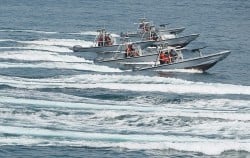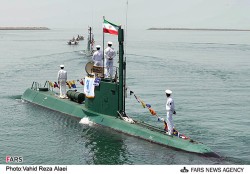
The 2013 Surface Navy Association’s Naval Heritage program topic was Operation Praying Mantis. The program featured first hand accounts of events that transpired in the Persian Gulf during the spring of 1988. Those naval operations culminated with an operation called Praying Mantis — the punitive attack against the Iranian navy on 18 April. The focus was on the dramatic tactical events that occured, and included a detailed description of the sinking of the Iranian Kaman-class corvette Joshan. Retired Navy Vice Adm. Anthony Less said at the forum that in 2006 Iran commissioned a new missile patrol boat named after the former Joshan. If the Iranians dare to disrupt shipping in the Persian Gulf again, “we’ll put this one on the bottom of the Persian Gulf with her namesake,” Less said.
The comment was the only reference in the forum to the current tensions in the region, but using Praying Mantis as a starting point for comparing what a conflict in the present-day Persian Gulf would look like is a good starting point.
A key reason why the situation in the Persian Gulf is much different today lies in the material condition of Iran’s vessels. In 1988 the small Iranian navy was largely degraded by the war with Iraq that was then in its eighth year. Iran did not have much of a navy in 1988, nor did it need one when the greatest threat they faced was an Iraqi army massed on its western border. In fact, on the very day of the Praying Mantis operation, the Iranians were fighting a massive battle near the Iraqi city of Basra. In contrast to 1988, the Iranian navy of today has been deliberately constructed and tailored to what Iran believes as necessary to meet the operational requirements to challenge the U.S. Navy.
Secondly, the protracted struggle with Iraq had placed great strain and inflicted tremendous losses on Iran (an estimated 2 million killed or wounded). A good visual of the geopolitical situation in 1988 is to picture three boxes of war that were affecting the Persian Gulf at that time. The first was the big box of the Cold War, inside of that was a medium box of the regional war between Iran and Iraq; and the third box was a smaller limited conflict with the United States. A key point is that the unique geopolitical environment of 1988 is not what the U.S. Navy will find in this region today. Present conditions would more represent a single box of war, and Iran will be able to fully concentrate the full weight of its national power on a single enemy without the fear of a Soviet invasion from Afghanistan or an Iraqi army breakthrough on the western border.

Dave Crist wrote in his recent book, The Twilight War, “In the Spring of 1991, [Iranian] military Officers met in Tehran to discuss future requirements in light of the recent war in Iraq and their own recent confrontation with the U.S. Navy . . . The naval officers concluded that their strategy against the United States had been sound, but they lacked the means to properly implement it.” The conclusion of the Iranian leaders in 1991 explains the past 25 years of weapon acquisitions and Iran’s apparent effort to build or acquire a wide variety of relatively low-cost asymmetric weapons. For example, Iran has scaled up its inventory of armed fast-attack surface craft, mines and cruise missiles from a handful in 1988 to thousands today. Further, it has invested in a hardened infrastructure to hide and protect their vast inventory of anti-access/area denial (A2/AD) weapons along the 1500 miles of Iranian coastline. While, one may be tempted to hubristically shrug off the threat of Iran’s seemingly odd assortment of A2/AD weapons as nothing more than a Wile E. Coyote collection of Acme rockets and gadgets, they would be wise to keep in mind the very real threat posed by those weapons. For example, the estimated 12 Yono-class mini-submarines now in Iran’s inventory are the same design that was used by North Korea to sink the South Korean corvette Cheonan in March of 2010. Also, the C-802 missile that struck the Israeli corvette Hanit during Israel’s 2006 operations against Hezbollah was provided by Iran. In short, Iran’s once scarce A2/AD weapons are now abundant and combat-proven.
Naval theorist Julian Corbett wrote, “The truth is, that the classes of ships which constitute a fleet are . . . the expression in material of the strategical [sic] and tactical ideas that prevail at any time.” While Iran’s eclectic assortment of mini-subs and speedboats awkwardly loaded with mines and missiles may seem incomparable to the impressive might of a U.S. surface action group, they represent the best expression of what Iranian leaders believe they need to fight a war at sea in the confines of the Persian Gulf. The lesson for today’s planners is that unlike 1988, where Iran unexpectedly found itself in a naval engagement with the US Navy, the Iranian leaders of 2013 have deliberately prepared and trained for a fight against the United States.
Praying Mantis is a good demonstration of how operations are constrained by objectives. A student of Praying Mantis will note that the plug was pulled on this operation when President Ronald Reagan felt that the objectives were achieved. To the frustration of some at the tactical level of the operation, Iranian ships remained floating and viable. A future conflict with Iran is also likely to be a limited war; however, the objectives will be very different. In 1988, Praying Mantis was executed as a limited eye-for-an-eye strike in response to the mining of the gulf that led to serious damage of the USS Samuel B. Roberts (FFG-58) four days prior to Praying Mantis. The objective of Praying Mantis was to deter and destroy Iran’s ability to disrupt the flow of commerce in the gulf. In contrast, while the objective for a future war with Iran will likely also be limited they will be more difficult to achieve. Specifically, destroying, or deterring, Iran’s nuclear ambitions will ostensibly be far more significant to Iran than the unexpected loss of two aging naval vessels and a couple of oil platforms. By all appearances Iran is likely to place a high value on maintaining its nuclear program. Therefore, it is unlikely it will give in easily to U.S. demands to cease and desist in its efforts. The value Iran will place on achieving this goal, coupled with its robust A2/AD arsenal, creates conditions for a much more costly, lethal and protracted campaign than Praying Mantis.
There are valuable lessons to be learned from Praying Mantis. Keeping in mind the fact that it has been 67 years since the U.S. Navy has tested its tactics and doctrine in the crucible of a war at sea should beg the question: How do we know we are getting it right when our last true test of maritime strategy was nearly seven decades ago? If one considers consider Praying Mantis as a useful test of the Navy’s sea control concept then what did we really learn? Each of the speakers in the forum echoed that “this was not a fair fight.” Despite the Navy’s lopsided victory on April 1988, a closer look at the wider conflict reveals that the Navy’s scorecard during this limited war was a mixed bag. First, it is important to remember that the U.S. surface action groups only confronted a force that had a single operational Harpoon missile, and it was only due to the skill of the USS Wainwright’s (CG-28) crew, or chance, that caused that one missile to miss. Further, while the Navy met its objectives during the wider “Tanker War” in which Praying Mantis occurred, it took losses from the small number of Iranian mines that were covertly seeded, and an errantly fired Iraqi Exocet missile. In the information domain the U.S. Navy erred tragically when the USS Vincennes (CG-49) mistakenly shot down a civilian airliner. While those losses and failures are painful to remember, they serve to point to the challenges that await us in the present age where far more lethal and far more abundant instruments of war will challenge our ability to gain and maintain sea control in the Persian Gulf if war should once again trouble these waters.




